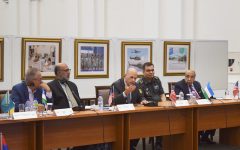The January Crisis in Kazakhstan?
March 11, 2022 2022-03-11 16:41The January Crisis in Kazakhstan?
By: CDR Hubert MROZ, POL Navy, CSAG CCJ5
24 Feb 2022
Overview:
On January 2, 2002, people took to the streets to protest high fuel prices in Zhanaozen and Aktau, major cities in the Mangystau region of western Kazakhstan. Liquefied Petroleum Gas (LPG) doubled its price from an equivalent of 11 to 23 cents (USD). Two days later, on January 4, the demonstrations spread across the country to Almaty, Atyrau, Aktobe, Uralsk, Taraz, Shymkent, Kyzylorda, Karaganda and to the capital of Nur-Sultan. Some governments buildings were torched and there was significant damage and destruction, especially in the inner cities of these locations. On January 5, the president imposed a two-week state of emergency, ending January 19, in three regions: Mangystau, Almaty and Nur-Sultan. Mr. Tokayev also ordered law enforcement agencies to “open fire without warning”. On the same day, the president accepted the resignation of the entire governing cabinet. Its members should serve until a new cabinet is formed. To meet one of the protesters’ demands, some price caps were introduced, including the LPG price, which has returned to the pre-protest levels. Allegedly, the president fired the ex-president’s nephew from the post of the Deputy Head of the Security Council, and later he took over the function of the Head of the Council, thus divesting Nursultan Nazarbayev of the post.
Initially, the police were used to disperse the crowds, but when the situation deteriorated President Tokayev requested assistance of the Collective Security Treaty Organization (CSTO) on January 5 by using Article 4 of the Treaty to launch a counter-terrorist operation. As a result, more than two thousand CSTO troops were deployed across the country, with most of them from Russia, then from Belarus, Tajikistan, and Kyrgyzstan. On Friday, Jan 7, Armenia decided to send about 70 soldiers. The rapid and effective deployment proved the high degree of mobility of the CSTO forces, as they were deployed within two days (on January 6-7) to the different destinations across the country. On January 6, Kazakhstan’s former chief of the National Security Committee (rus. Комитет Национальной Безопасности – KNB) was detained over treason. After talks between Jinping and Tokayev on January 7, China declared its readiness to assist the Kazakh government both financially and militarily, while stating the Shanghai Cooperation Organization’s (SCO) was prepared to counter terrorism. In total, the clashes left 225 dead, including 19 security personnel. Reportedly, one of them was decapitated. There were approximately 800 police and servicemen injured and about 5,800 people were detained, along with a sizable number of foreigners. On January 8, President Tokayev stated that the situation was under control.
Key Points:
- While the January protests in Kazakhstan initially began as a demonstration of public dissatisfaction, they were likely used by certain actors to achieve their own purposes.
- President Putin seems to be the biggest winner with his strategic message, “the savior of Kazakhstan” and the one who “deals the cards” in the post-Soviet bloc.
- The January riots in Kazakhstan were probably part of Russia’s broader campaign to improve its influence over Central Asia.
- History will also judge President Tokayev whether his decisions were justified and dictated by the raison d’état and concern for the citizens, or if it was a battle for the throne in competition with former President Nursultan Nazarbayev.
The opinions and conclusions expressed herein are those of a number of international officers within the Combined Strategic Analysis Group (CSAG) and do not necessarily reflect the views of United States Central Command, not of the nations represented within the CSAG or any other governmental agency.







